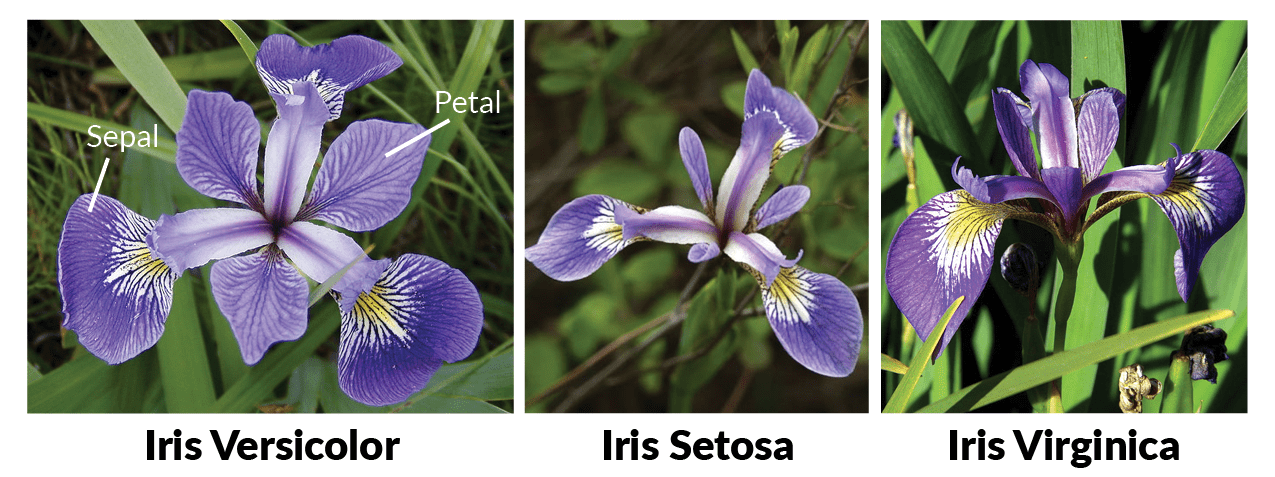Case Study (IRIS PLANT) :¶
SKLearrn (K-Nearest Neighbors (K-NN))¶
The data set contains 3 classes of 50 instances each, where each class refers to a type of iris plant. The attribute to be predicted is the class of iris plant. The classes are as follows: 1. Iris Setosa, 2. Iris Versicolour, 3. Iris Virginica
There are 4 features:
- sepalLength: sepal length in cm
- sepalWidth: sepal width in cm
- petalLength: petal length in cm
- petalWidth: petal width in cm
There are 3 classes represneting class label of iris flower {1,2,3}
- Iris Setosa
- Iris Versicolour
- Iris Virginica
Dr. Ryan @STEMplicity

Importing the Relevant Libraries¶
In [1]:
import numpy as np
import pandas as pd
import matplotlib.pyplot as plt
import seaborn as sns
sns.set()
Importing the Dataset¶
In [2]:
url = "https://datascienceschools.github.io/Machine_Learning/Classification_Models_CaseStudies/Iris.csv"
df = pd.read_csv(url)
df.head()
Out[2]:
Exploring the Dataset¶
ScatterPlot¶
In [3]:
plt.figure(figsize=(10,10))
plt.subplot(2,2,1)
sns.scatterplot(df['SepalLengthCm'], df['SepalWidthCm'], hue = df['Species'])
plt.subplot(2,2,2)
sns.scatterplot(df['PetalLengthCm'], df['PetalWidthCm'], hue = df[ 'Species'])
plt.show()
Violinplot¶
In [4]:
f, ax = plt.subplots(2,2, figsize=(10,10))
f00 = sns.violinplot(df['Species'], df['PetalLengthCm'], ax=ax[0,0])
f01 = sns.violinplot(df['Species'],df['PetalWidthCm'], ax=ax[0,1])
f10 = sns.violinplot(df['Species'], df['SepalLengthCm'], ax=ax[1,0])
f11 = sns.violinplot(df['Species'],df['SepalWidthCm'], ax=ax[1,1])
Pairplot¶
In [5]:
sns.pairplot(df, hue = 'Species')
plt.show()
Heatmap¶
In [6]:
corr = df.corr()
matrix = np.triu(corr)
sns.heatmap(corr, annot=True, mask = matrix)
plt.show()
Declaring the Dependent & the Independent Variables¶
In [7]:
X = df.iloc[:, :-1].values
y = df.iloc[:, -1].values
Label Encoding the Dependent Variable¶
In [8]:
from sklearn.preprocessing import LabelEncoder
le = LabelEncoder()
y = le.fit_transform(y)
Splitting the Dataset into the Training Set and Test Set¶
In [9]:
from sklearn.model_selection import train_test_split
X_train, X_test, y_train, y_test = train_test_split(X, y, test_size = 0.20, random_state = 1)
Feature Scaling¶
from sklearn.preprocessing import StandardScaler
sc = StandardScaler()
X_train = sc.fit_transform(X_train)
X_test = sc.transform(X_test)
Training the K-Nearest Neighbors Model¶
In [10]:
from sklearn.neighbors import KNeighborsClassifier
model = KNeighborsClassifier(n_neighbors = 5, metric = 'minkowski', p = 2)
model.fit(X_train, y_train)
Out[10]:
Predicting the Test Set Results¶
In [11]:
y_pred = model.predict(X_test)
Confusion Matrix¶
In [12]:
from sklearn.metrics import confusion_matrix, accuracy_score
cm = confusion_matrix(y_test, y_pred)
accuracy = accuracy_score(y_test, y_pred)
print("Accuracy is: {:.2f} %".format(accuracy*100))
sns.heatmap(cm, annot=True, fmt="d")
plt.show()
Classification Report¶
In [13]:
from sklearn.metrics import classification_report
print(classification_report(y_test,y_pred))
k-Fold Cross Validation¶
In [14]:
from sklearn.model_selection import cross_val_score
accuracies = cross_val_score(estimator = model, X = X_train, y = y_train, cv = 10)
print("Accuracy: {:.2f} %".format(accuracies.mean()*100))
print("Standard Deviation: {:.2f} %".format(accuracies.std()*100))